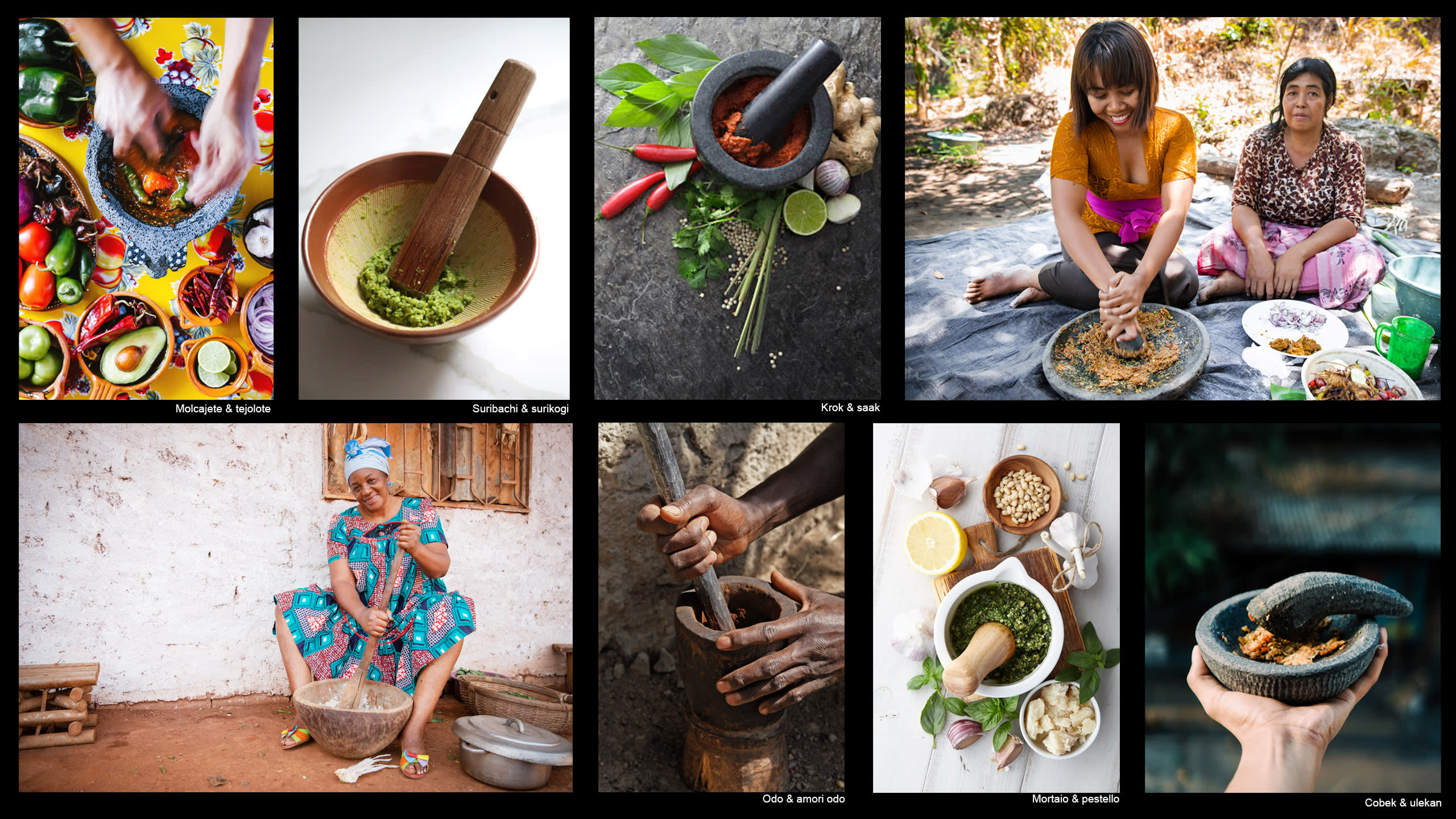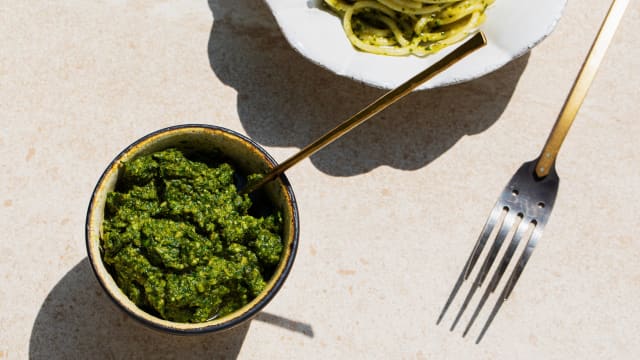The Mindfulness of Mortars

Few ways of connecting with your food are as gratifying as pounding something in a mortar. It’s physical, using your whole body, and engages and rewards all five senses in equal measure. Mortars also produce better-tasting (and in some cases healthier) food than processing by other means. And somewhat ironically, these humble ancient tools also allow for extraordinary precision and refinement.
Stone tools are at least a million years older than humanity itself, dating back to about 3.3 million years ago in East Africa. They were likely made by Australopithecus afarensis, the proto-human species made famous by Lucy, the fossil discovered in Ethiopia in 1974. Today, stone tools are still alive and well in kitchens around the world. Every culture uses some form of the tools — sometimes several, using stone, ceramic, and/or wood — for grinding grains, spices, sauces: anything that needs to be pulverized, puréed, or pounded.
Adding Texture and Taste
The textures that these tools create, from creamy aioli to sturdy mole, cannot be achieved mechanically. Food processors and blenders are admirable efficiencies, for sure, but they tear through everything the same way. There’s no subtlety or nuance to their work. With a mortar, you can tailor the consistency precisely to the intended result, ranging from coarse to fine — and, most appealingly, a continuum that encompasses coarse, fine, and everything between them. By adding ingredients in a particular order, you can ensure that some things get utterly pulverized while others are only lightly bruised. This method allows for customization at the (literally) granular level.

Here’s a cursory tour though some of the world’s notable exemplars:
- “Pok pok,” the popular Thai slang name for som tam (green papaya salad), is onomatopoeia for the sound of a saak (pestle) hitting a krok (mortar).
- Fufu, the West African staple made from pounded cooked cassava or other tubers, relies on a mortar, pestle, and elbow grease for its fluffy texture. Many regional versions of the tool (like the Yoruba odo & amori odo in Nigeria) have extra-long pestles so they can be used while standing, with the mortar resting on the ground, for greatly improved leverage and impact.
- Marble examples of mortai from Italy, with pestelli made from beech or olive wood, produce sublime pesto. Any self-respecting Ligurian nonna will tell you that one simply cannot make proper pesto in a machine.
- Many of the sambals, pastes, and sauces that make Indonesian food so richly delicious come together in a cobek, a shallow stone vessel with a distinctively curved pestle called an ulekan.
- Guacamole made in a basalt molcajete has a creamy, yet beautifully varied texture — and, not for nothing, the vessel makes an ideal serving dish. If you want to see just what these tools are capable of, try making mole from scratch, grinding each component under your perfectly ergonomic tejolote.
- The ridges inside a Japanese suribachi, a flared ceramic bowl with grooves combed into the unglazed interior, make short work of everything from sesame seeds to sturdy greens when pounded with a wooden surikogi. Make your own gomasio or goma-ae and be converted.
Transform Food by Hand
Using these tools connects us with the past, but also with the present moment. To work this way, using unique ratios of force and finesse to transform your food by hand, constitutes a rewarding form of meditation. Mortars require commitment; they need more time than a food processor, and demand sustained attention to produce the desired result. You can focus on the task, watching separate ingredients come together, forming something much more than the sum of its components. The nature of this process means that your hands, your style, and even your intention can all be felt in the finished food.
There’s a rhythm to this work, and sometimes even a decent upper-body workout. Match your breathing to the pounding or put on some music and settle into a groove. With all the variations possible — pounding, scraping, grinding, stirring — you can syncopate to your heart’s content, or arrive at some combination of iambs, anapests, trochees, and spondees that allows you to write or recite poetry while you cook.
Crushing highly aromatic ingredients in a mortar can also be a powerful form of aromatherapy. Try making a Thai curry paste with fresh ginger, galangal, lemongrass, garlic, chiles, cilantro, and lime leaves and see if your worries don’t evaporate on the spot. And because working this way requires starting with whole ingredients, and unlocks more of their flavor, your food will taste better. The time you invest in pounding and stirring will yield dividends in your dinner.
All the impact and friction bring nutritional benefit, too. Take garlic, for example. It contains allicin, a compound that has wide-ranging health benefits: it’s antibacterial, antifungal, can lower blood pressure and cholesterol, and research has shown it even kills some cancer cells.
Allicin is inert in a whole garlic clove, only activated when the cells inside the clove are damaged: cut or broken. If you chop a clove, you’re damaging many of the cells, but if you pound it into paste with a pestle you’re damaging all of them. More broken garlic cells equal more allicin in your food. If approximately 95% of the things commonly made in mortars include garlic, using them will improve your health. That’s science!
These perfect tools make food the way it has been prepared for centuries, millennia — even epochs. You’ll taste the difference, and you’ll feel it too. Your cooking will improve, and so will your forearm tone. You might even find that any young people in your house take a shine to helping you prep in a way they haven’t before (just ask any 3-year-old: bashing things with rocks is fun). Instead of doom-scrolling or channel-surfing, why not revel in the process of spending your time pounding a pile of fragrant delicacies into something sublime?
Key Takeaways
- Using mortars gives better texture to food.
- It release subtle flavors and aromas.
- Mortars are versatile cooking aids.



